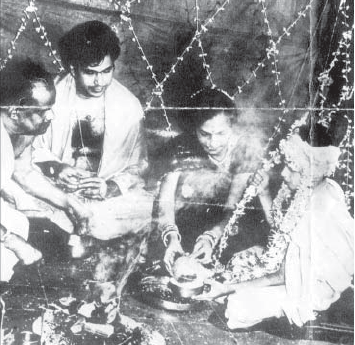Saraswat
Brahmins
South and North Kanara are
the “native place” of the 1,500,000 Saraswats. A small, highly urbanised
community, the Saraswats are today divided into three main groups: the
Vaishnava Goud Saraswats, the Smarta Chitrapur Saraswats and the
Shenvis. Although the Kanaras and the region around them are their most recent
home, more than ninety per cent of the erstwhile Saraswat landowners have
migrated to cities like Bombay, Bangalore and Dharwar in search of education or
employment.
Most of the community’s
migrant members, who are today found living in cities as far apart as Calcutta
and Trivandrum, have shown a unique penchant for merging with the local scene,
adopting new customs and food habits and, quite often, mastering the language of
their new home. Neither Maharashtrian nor completely Mysorean, their way of life
and their culture draw upon the finest points of both regions and make them
their own. Speaking Konkani, a language which has several dialects but no script
of its own, the Saraswats are largely a vegetarian community, whose
coconut-based cuisine is famed for its variety.

A Saraswat Jenav ceremony
The name Saraswat suggests
the legary origin of the community. They are Aryans, originally inhabiting the
valley of the river Saraswati in Kashmir. The gotras of the Saraswats originate
from the names of some of these settlers. Examples: Bharadwaja, Vatsa,
Kaundinya and Kasyapa.
Nowhere has the Saraswat
pioneering spirit been more in evidence than in the field of co-operation. The
first people in India - many say in Asia - to plan and execute a scheme for a
co-operative housing project, the Saraswats today have successfully formed
every conceivable kind of co-operative activity. They have set up holiday homes,
schools, housing projects, banks, libraries, religious shrines and social
welfare or self-help units.
The winds of change that
education has brought have blown away the cobwebs of social taboos and
meaningless customs, resulting in a voluntary acceptance of widow remarriages,
equal status for women and the rejection of unwholesome practices like the
dowry. There has been, in addition, a keen awareness of family planning, the
average Saraswat family not having more than three children.
An ever-increasing number of
young Saraswats have married outside the community. There are innumerable
examples of Saraswats marrying Jews, Christians, Muslims, Parsis, and
foreigners, as well as Hindus of different castes from different States.
Saraswat Names
Goud Saraswats (Vaishnavites):
Kamath, Pai, Shenoy, Naik.
Shenvis (Smartas): Sanzgiri,
Wagle, Dabhol-kar, Telang, Lad, Dalvi, Bhe, Naik, Kabadi, Rege, Mulgaonkar,
Kasbekar, Mahale, Rajad-hyaksha, Rangnekar, Karade.
Chitrapur Saraswats (Sm-artas):
Ondoor, Yerdoor, Murur, Nalkur, Aidoor, Aroor, Yellur (these names in Kannada
literally mean “one village”, “two villages “ and so on till we come to seven
villages - denoting perhaps that villages in Karnataka in the past were
numerically arranged, the inhabitants of each being known after the numeral),
Chandavarkar, Koppikar, Benegal, Padbidri, Padukone, Dhareshwar, Murdeshwar,
Neeshwar, Pandit, Nadkarni, Kulkarni, Kalbag, Sirur.
We are thankful to Sh. Sanjay
Godbole, who has great sense of History, for providing us this material, which
appeared in the Illustrated weekly of India Annual, 1972). --Editor
Source: Kashmir
Sentinel
|

